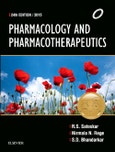. Trusted Pharmacology book with emphasis on pathophysiology, clinical pharmacology and therapeutics, presenting information in integrated manner.
. Up-to-date information supplemented with tables and diagrams, having: - therapy of important diseases presented in boxes. - current guidelines to support therapeutic decisions - tips for practising physicians.
. Uses integrated approach intertwining current knowledge of pathophysiology of the disease, pharmacology of available drugs and strategies for medical management of diseases. . Balances the complexity and simplicity of scientific content to provide students of medicine and/or pharmacy an insight into rational therapeutics.
Table of Contents
Section I: General Pharmacology1. General Considerations and Pharmacokinetics
2. Pharmacodynamics - Drug Receptor Interaction; Adverse Drug Reactions
3. Principles of Drug Prescribing; Factors Modifying the Effects of a Drug; and Drug Interactions
4. Drug Invention; New Drug Development; and Drug Assay
Section II: Drugs Acting on the Central Nervous System
5. General Considerations
6. Aliphatic Alcohols
7. General Anaesthetics
8. Sedatives, Hypnotics and Pharmacotherapy of Sleep Disorders
9. Drugs Effective in Seizure Disorders
10. Opioid Analgesics and Antagonists
11. Analgesic-Antipyretics and Nonsteroidal Anti-inflammatory Drugs (NSAIDs)
12. Central Nervous System Stimulants
13. Psychopharmacology - 1: Introduction, Antipsychotic Drugs and Pharmacotherapy of Major Psychotic Disorders
14. Psychopharmacology - 2: Anxiolytics, Antidepressants and Mood Modifying Agents
15. Drug Therapy of Parkinsonism and Other Neurodegenerative Disorders
Section III: Local Anaesthetics
16. Cocaine, Procaine and Other Synthetic Local Anaesthetics
Section IV: Autonomic Nervous System
17. General Considerations
18. Adrenergic Agonists and Antagonists
19. Cholinergic Drugs
20. Muscarinic Receptor Blocking Drugs; Pharmacotherapy of Bladder Dysfunction
21. Ganglion Stimulating and Blocking Drugs
22. Skeletal Muscle Relaxants
Section V: Other Biogenic Amines and Polypeptides
23. Histamine and Antihistaminic Drugs
24. 5-Hydroxytryptamine (Serotonin), its Agonists and Antagonists; and Treatment of Migraine
25. Angiotensin, Kinins, Leukotrienes, Prostaglandins and Cytokines
Section VI: Drugs Used in Respiratory Disorders
26. Pharmacotherapy of Cough
27. Pharmacotherapy of Bronchial Asthma, COPD and Rhinitis
Section VII: Cardiovascular Drugs
28. Pharmacotherapy of Cardiac Arrhythmias
29. Pharmacotherapy of Angina Pectoris, Acute MI and Peripheral Vascular Diseases
30. Pharmacotherapy of Hypertension, Pulmonary Hypertension and Orthostatic Hypotension
31. Pharmacotherapy of Heart Failure
32. Pharmacotherapy of Shock
Section VIII: Drugs Acting on Blood and Blood Forming Organs
33. Drugs and Blood Coagulation
34. Drugs Effective in Iron Deficiency and Other Related Anemias
35. Drugs Effective in Megaloblastic Anemias and Neutropenia
36. Drug-Induced Blood Dyscrasias
Section IX: Water, Electrolytes and Drugs Affecting Renal Functions
37. Water, Sodium, Potassium and Hydrion Metabolism
38. Nutritional Supplementation Therapy
39. Diuretic and Anti-Diuretic Drugs
Section X: Drugs Used in Disorders of the Gastrointestinal Tract
40. Appetite Stimulants, Digestants, Antiflatulents, Appetite Suppressants and Hypolipidemic Agents
41. Emetics, Drug Therapy of Vomiting, Vertigo and Diarrhoea
42. Pharmacotherapy of Constipation
43. Pharmacotherapy of Peptic Ulcer Disease
Section XI: Oxytocics and Uterine Relaxants
44. Pharmacology of Ergot Alkaloids, Oxytocin, other Oxytocics and Uterine Relaxants
Section XII: Chemotherapy
45. Sulfonamides, Trimethoprim, Cotrimoxazole, Nitrofurans and Quinolones
46. Penicillins and Other Antibiotics Effective Mainly Against Gram Positive Organisms
47. Aminoglycosides and Other Antibiotics Effective Mainly Against Gram Negative Organisms
48. Antibiotics Effective Against Both Gram Positive and Gram Negative Organisms
49. Tetracyclines and Chloramphenicol
50. Antifungal Agents
51. General Principles of Chemotherapy of Infections
52. Chemotherapy of Urinary Tract Infections
53. Chemotherapy of Sexually Transmitted Diseases
54. Chemotherapy of Tuberculosis
55. Chemotherapy of Leprosy
56. Chemotherapy of Malaria
57. Chemotherapy of Amoebiasis
58. Chemotherapy of Other Protozoal Infections
59. Chemotherapy of Viral Infections
60. Chemotherapy of Helminthiases
61. Chemotherapy of Malignancy
62. Antiseptics, Disinfectants and Insecticides
Section XIII: Drugs Used in Endocrine Disorders
63. Anterior Pituitary Hormones
64. Thyroid Hormones and Antithyroid Drugs
65. Pancreatic Hormones, Antidiabetic Drugs and Pharmacotherapy of Diabetes Mellitus
66. Adrenal Cortical Steroids
67. Gonadotropins, Estrogens and Progestins
68. Antifertility Agents and Ovulation Inducing Drugs
69. Androgens, Anabolic Steroids and Antiandrogens
70. Calcium, Phosphorus, Fluoride and Magnesium Metabolism; Parathyroid Hormone and Vitamin D; Treatment of Osteoporosis
Section XIV: Drugs Used in Common Skin and Eye Disorders
71. Pharmacotherapy of Common Skin Disorders and Skin Protectives
72. Ocular Pharmacology
Section XV: Immunopharmacology
73. General Considerations: Vaccines and Antisera
74. Immunoglobulins, Monoclonal Antibodies, Immunosupressants and Immunomodulators
Section XVI: Miscellaneous
75. Pharmacotherapy of Gout, Rheumatoid Arthritis and Osteoarthritis
76. Metals and Their Antagonists
77. Gases: Therapeutic and Toxic
78. Enzymes in Therapy
79. Vitamins and Antioxidants
80. Drugs, Pregnancy and the Infant
Authors
RS Satoskar Former Professor & Head, Department of Pharmacology,Seth GS Medical College; TN Medical College; LTM Medical College
and Associate in Clinical Medicine, KEM Hospital, Mumbai, India.
Nirmala Rege
MBBS, MD, Professor and Head, Department of Pharmacology and Therapeutics
Seth GS Medical College and KEM Hospital, Parel , Mumbai - 400 012
SD Bhandarkar Former Hon. Professor & Head, Department of Endocrinology
and Associate in Clinical Pharmacology
Seth GS Medical College and KEM Hospital,
Mumbai, India.








